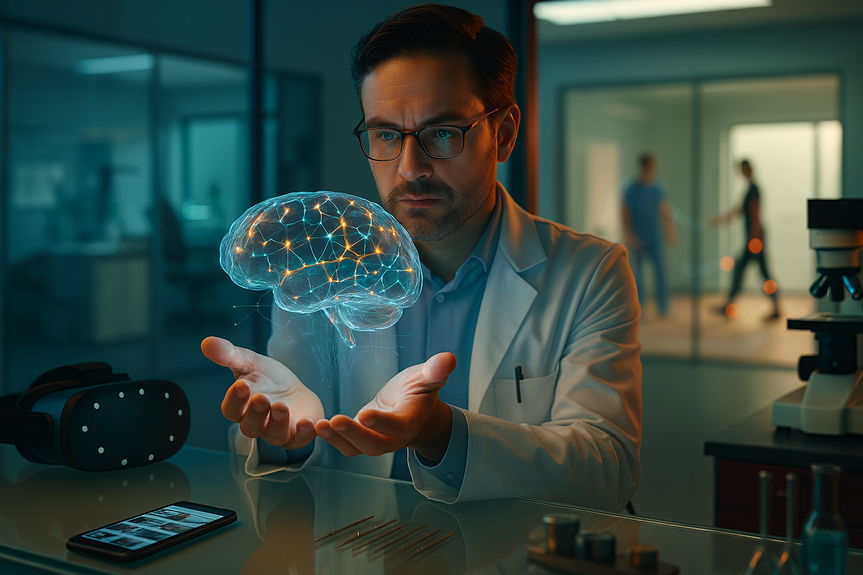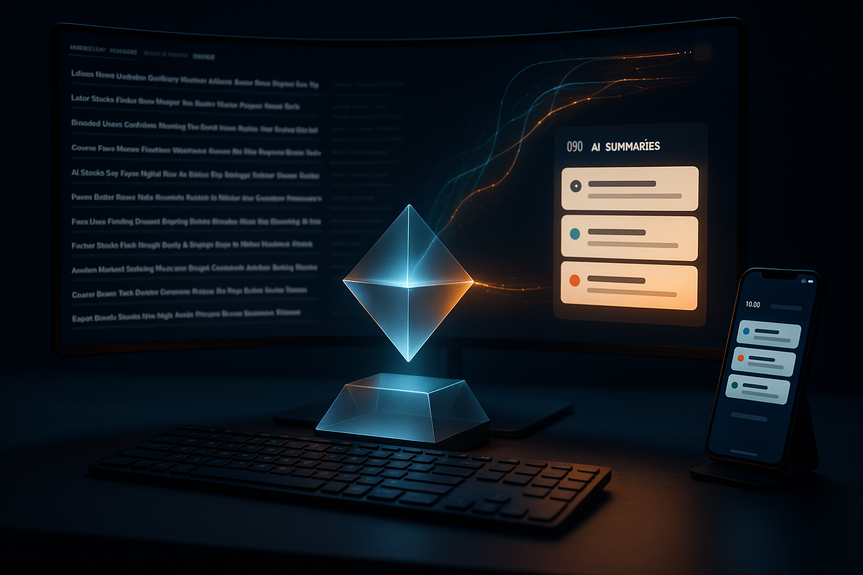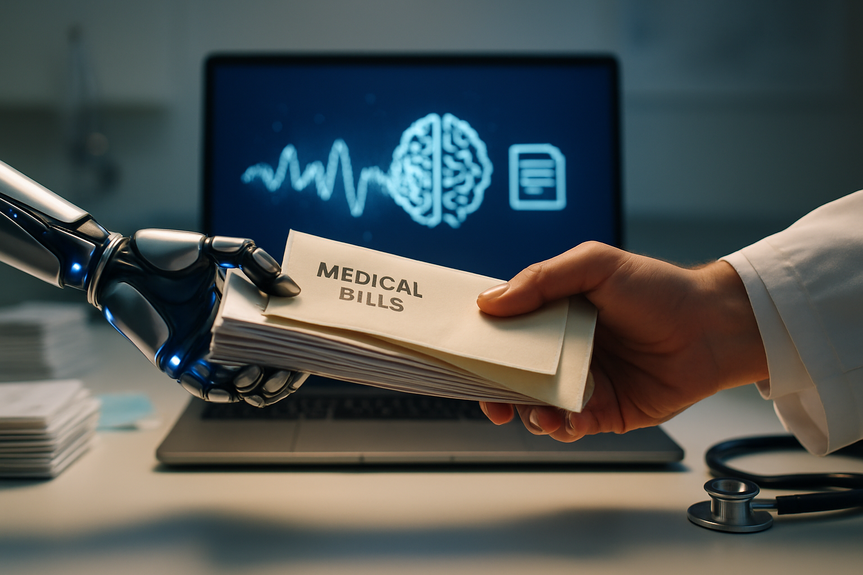
AI News
25 Nov 2025
Read 16 min
AI tools for neuroscience research: How to decode brains
AI tools for neuroscience research speed discovery, decoding neuronal signals and improving diagnoses.
Brain-Like Networks That Learn Faster
Why perception needs more than pattern matching
We trust our senses because the brain blends sight, touch, and sound into a stable picture of the world. Standard artificial neural networks can also recognize objects, but they overlook key features of real brains. They do not capture the full mix of neuron types, or the detailed wiring that links layers and columns. A research team set out to add these missing pieces. They built models that include more realistic neuron diversity and the way neurons connect across space. When they trained these “brain-like” networks on sensory tasks, the systems learned faster. They hit the same accuracy but needed less data and less time.What changes inside the model
By adding diverse neuron dynamics and more faithful connectivity, the model can reuse structure to generalize. It does not need to see every example to find the right rule. This is efficient learning, and it mirrors the idea that brains do more with less by leaning on built-in structure and constraints.Why this matters to labs and clinics
– It reduces training costs when data are scarce, which is common in neuroscience. – It can make models easier to interpret, because parts map to known brain features. – It invites a two-way street: biology guides model design, and models suggest new experiments that test which features of real brains drive perception.AI tools for neuroscience research: Brain-inspired design in practice
We often ask if artificial networks can match brains. A better question is how they can help explain brains. When models that match neural diversity and wiring learn more efficiently, they hint that these properties matter for perception. Scientists can then test this idea in animals or in human imaging experiments. This loop—build a model, test a prediction, refine the model—pushes both AI and neuroscience forward.Reverse-Engineering Single Neurons
The problem with measuring only the output
Most brain disorders disrupt how neurons talk. Patch clamp recordings capture the electrical response of a neuron, but they do not directly tell us which ion channels create that response. Classic models run forward: start with a set of channels and a shape for the neuron, then simulate the resulting voltage trace. That is useful, but slow if you must try many combinations to match data.From voltage traces to channel recipes
A team led by a university lab built a deep learning tool called a “NeuroInverter.” It does the inverse problem: it takes the measured voltage response of a neuron and predicts the likely mix of ion channels that produced it. They tested the tool across more than 170 neuron types and recovered informative channel profiles.Digital twins for disease
If you can infer the channel mix from a patient’s neuron, you can build a “digital twin” of that cell. You can then test how a genetic change or a drug alters the model’s channels and output. This can speed discovery in epilepsy, schizophrenia, and other disorders that change excitability. It also gives researchers a way to compare cells across patients in a standard framework.What to watch next
– Validation: compare predictions with pharmacology that blocks specific channels. – Generalization: ensure the tool works across labs, species, and recording setups. – Integration: link channel predictions to gene expression and morphology for a fuller picture.Smartphone Gait Analysis That Works Anywhere
Why gait scoring needs an upgrade
Aging, stroke, and multiple sclerosis often impair walking. Clinicians must measure gait to plan therapy. Visual ratings can be subjective. Motion capture systems are precise but expensive and hard to access. Many clinics and community settings need a low-cost, reliable alternative.Machine learning from simple videos
A rehabilitation research team used smartphone videos of people walking. They applied pose estimation and trained classifiers on normal and impaired patterns. The system identified key gait deficits with more than 85 percent accuracy. This level is strong enough to support screening, track progress, and flag when a care plan should change.Impact for health systems
– Lower barriers: almost every clinic and many homes have a smartphone. – More data: frequent videos build a richer profile than rare lab visits. – Faster feedback: therapists can adjust exercises in days, not weeks. – Broader reach: rural and low-resource settings can access objective measures.Limits and guardrails
– Standardize camera angles and lighting to avoid bias. – Test on diverse ages, body types, and walking aids. – Protect privacy: store and process videos with strong consent and encryption.Predicting Freezing of Gait in Parkinson’s Before It Hits
A sudden stop that risks falls
Some people with Parkinson’s disease suddenly cannot step forward. This “freezing of gait” raises fall risk and lowers quality of life. Deep brain stimulation helps some symptoms but struggles here, because clinicians cannot predict when freezing will start.Virtual reality as a safe trigger
Researchers built virtual scenarios that often bring on freezing, like narrow doorways or crowds. They recorded brain signals while participants navigated these scenes. They found neural patterns that signaled the approach of a freeze. A machine learning model trained on these patterns predicted freezing episodes before they occurred.Toward adaptive deep brain stimulation
If a system can forecast freezing, it can trigger a targeted stimulation burst at the right time. This “adaptive DBS” could prevent many episodes. The study suggests a path to real-time devices that adjust to the brain’s state, rather than stimulate on a fixed schedule.Next steps
– Validate across more participants and daily-life conditions. – Test on-device models that run with very low latency. – Balance sensitivity and specificity to avoid false alarms.Decoding Meaning, Not Just Sounds, from Brain Activity
Beyond phonetics in speech BCIs
Brain-computer interfaces help people who cannot speak. Many current systems decode the sounds of speech, but they can confuse words that sound alike. Meaning matters. If a system knows the category of a word, it can reduce errors and speed communication.Reading semantic categories
A neurosurgery research team recorded brain activity while people thought of words from different categories, like animals or clothing. They trained a learning algorithm to classify the category from the neural data. The model picked the correct category about 77 percent of the time.Why adding semantics boosts performance
Semantics gives context. When a decoder knows the user is thinking of an “animal,” it can narrow choices and pick the right term more often. In the future, teams can fuse semantic, phonetic, and motor signals (like imagined tongue or lip movement). That blend could power faster and more reliable communication.Ethics and safety
– Consent must be clear, specific, and ongoing. – Data must be secured, anonymized, and used only for approved purposes. – Decoders must avoid inferring private thoughts outside intended tasks.Shared Lessons Across These Breakthroughs
What makes these projects work
– Ground truth matters: reliable labels and careful experiments produce better models. – Biological priors help: brain-like structure and constraints improve data efficiency. – Closed loops win: systems that predict, test, and adapt move faster to clinic. – Simple inputs are powerful: phone videos and everyday tasks can deliver real value.What still needs care
– Generalization: models must work across patients, devices, and sites. – Explainability: clinicians need to trust why a model fires. – Latency: real-time prediction requires low-power, on-device inference. – Fairness: training data must represent diverse users to avoid bias. – Regulation: clinical AI must pass safety and effectiveness reviews.How Labs and Clinics Can Start Now
Build the right team
Pair neuroscientists with machine learning engineers, clinicians, and ethicists from day one. Set a shared outcome, like reducing falls or speeding diagnosis. Agree on metrics that matter to patients, not just accuracy on a test set.Choose smart data and baselines
– Use open datasets to warm-start models and benchmarks. – Collect new data with consistent protocols and metadata. – Record outcomes that reflect daily life, not only lab performance.Prototype with practical tools
– Start with smartphones and affordable sensors. – Run pilots that fit into current clinic workflows. – Measure time saved, costs avoided, and patient satisfaction.Test for robustness
– Stress-test models with noise, different lighting, and varied movement speeds. – Do cross-site validation to catch hidden biases. – Plan for model drift; schedule retraining with fresh data.Address privacy and consent early
– Store data securely and minimize access. – Use on-device processing when possible. – Explain benefits and risks in plain language to all participants.Pick deployment paths with clear value
For gait, a clinic app that flags risk and suggests exercises may be enough. For Parkinson’s freezing, aim for a research device that reads and stimulates in real time in controlled trials. For BCIs, build a staged plan that starts with semantic hints to support a phonetic decoder, then adds more signals as evidence grows.Where AI Meets Biology Most Productively
AI models often shine when they respect biology rather than replace it. The “brain-like” networks learned faster because they reflected real neural structure. The neuron “inverter” worked because it focused on biophysical causes, not just patterns. The gait tools succeeded because they used accessible data and targeted a clear need. The freezing and BCI projects advanced by designing experiments that isolate the signal a model can learn. This shows a path forward: design with biology in mind, collect high-quality data, and aim for decisions that improve daily life. When we treat models as partners that test ideas, not oracles that hand down answers, we get better science and better care.The Road Ahead
We can now see how AI can guide both discovery and treatment. It can point to which ion channels to test, which gait feature signals trouble, and which neural pattern hints at a freeze or a word. Each success builds trust and sets a higher bar for the next tool. The most exciting part is the shift from passive analysis to proactive support. Models that learn from brain signals can warn before a symptom appears. Systems that decode meaning can help people speak again. Networks shaped by biology can teach us which features of the brain matter most for perception and action. As more teams adopt AI tools for neuroscience research, progress will depend on careful validation, patient safety, and fair access. With those guardrails, we can turn lab demos into reliable devices and move from impressive accuracy to real-world impact.(Source: https://www.the-scientist.com/ai-tools-unravel-thoughts-actions-and-neuronal-makeup-73779)
For more news: Click Here
FAQ
Contents






